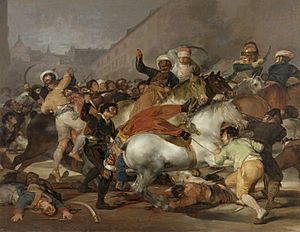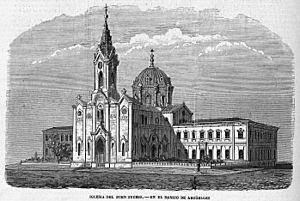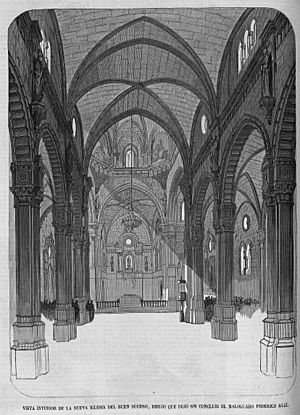Iglesia del Buen Suceso facts for kids
The Iglesia de Nuestra Señora del Buen Suceso, often called the Iglesia del Buen Suceso (which means "Church of Good Success"), was a famous church in Madrid, Spain. It stood on the eastern side of the Puerta del Sol, a very busy square in the city. This church actually started as a hospital called the Royal Hospital of the Court, built way back in 1483. By 1590, it was used as both a hospital and a church.
For many years, the church had a special clock that helped people tell time in the Puerta del Sol. Later, a better clock was put on the Real Casa de Correos building nearby. The church was eventually torn down in 1854. This happened during a time when many church properties were taken by the government, which made space for the Puerta del Sol to become bigger.
In 2006, during work to expand the Madrid Metro system, old parts of the church were found deep underground. This discovery caused a 6-month delay in construction. The old remains were carefully restored and can now be seen by visitors at the Sol Metro Station.
Contents
History of the Church
The original building was started by a kind man named Bernardino de Obregón. He founded the Hospital of the Buen Suceso in Madrid. Many historians have studied the story of this building, including famous writers like Ramón de Mesonero Romanos. The area where the church stood was once home to a hospital and later became known for a large "Tío Pepe" neon sign.
A Traveling Hospital
The church's story begins with a hospital that traveled with the Spanish royal family. This hospital, called the Hospital Real de la Corte (Royal Hospital of the Court), was founded by the Catholic Monarchs in 1489. Its job was to care for royal family members and their helpers who got sick or had accidents.
Later, Emperor Charles V, Holy Roman Emperor decided to move the hospital permanently to the growing city of Madrid. He ordered it to be built outside the old city walls, right next to the Puerta del Sol. This hospital was officially confirmed in 1529 by Pope Clement VII.
The hospital was built where an old chapel once stood. The construction wasn't very strong, so the building often needed repairs. Even though it was a royal hospital, it wasn't much different from the other 18 hospitals in Madrid at the time. However, because it was supported by the royal family, it had good supplies.
Building the Church
In 1587, King Philip II decided to reduce the number of hospitals in Madrid. In 1567, some walls were torn down, and nearby houses were taken to make the area bigger. The small hospital church slowly became more important as a central place in the city.
By 1590, the hospital building was showing signs of weakness. Philip II asked the city officials to build a new church and hospital in the same spot. He chose architect Diego Sillero for the job. The old building was then torn down.
However, the death of Juan de Herrera, who inspired the design, caused delays. The main reason for the delay was a lack of money, which stopped the building work for several years. In 1601, King Philip III moved the royal court to Valladolid.
When the court returned to Madrid in 1606, the construction of the church sped up. The stone work was done by Agustín de Argüelles. The church was finished in September 1611. The altar was put in place in 1612, and the side chapels were completed in 1628.
The church became a very important part of the Puerta del Sol. In the 17th century, the Puerta del Sol was divided into two parts. The eastern part was dominated by the church's entrance area, which was a popular meeting spot. In 1695, part of the church was found to be falling apart. They decided to make it bigger by using some of the entrance area, which meant building a new front and changing the dome. The new church was finished in 1700.
The Dos de Mayo Uprising
During the uprising of May 2, 1808, the church was badly damaged. The fights against the French army in the Puerta del Sol greatly affected its structure. The Iglesia del Buen Suceso became a symbol of Madrid's resistance.
Years passed after this event, and it wasn't until 1839 that the church was fully rebuilt. This work was led by Narciso Pascual Colomer, who wanted to update the church's design to fit the style of the time.
Demolition for Puerta del Sol's Expansion
Because of a major plan to redesign the Puerta del Sol, the church and hospital began to be torn down on February 24, 1854. Only some columns from the building were saved and moved to another house.
The famous clock from the church's front, which people used to tell time in the Puerta del Sol, was moved to the Real Casa de Correos. It became the main clock for the Puerta del Sol, which it still is today. The church completely disappeared from the square. In its place, the Grand Hôtel de París was built, which later featured the famous "Tío Pepe" neon sign.
Rediscovery of Remains
When renovation work began in 2005, the church's old foundations were surprisingly found in 2006. These remains were only about a meter and a half deep. It was unexpected to find them in such good condition, especially after so much tunneling work by the Madrid Metro in the 1910s.
Instead of moving the remains to another location, they were buried a few meters deeper. Today, you can see them in the connecting hallways between the Cercanías de Madrid train station and the Metro at Sol Station.
The New Church Site
After the old church was demolished, a new Iglesia del Buen Suceso was built in the Argüelles neighborhood of Madrid. This new church, located at Princesa 43, was opened in 1868. It was designed by Agustín Ortiz de Villajos.
During the Spanish Civil War, the church was closed, but the hospital continued to operate. The area was heavily bombed, and the church was left in ruins. After the war, the building was rebuilt.
In 1975, the building, which was again in danger of collapsing, began to be torn down. A new residential and commercial building with a modern metal front was planned for the block, along with a new church to match it.
The current church was opened on April 17, 1982. On October 22, 2006, a special ceremony took place to celebrate 400 years since the discovery of the image of Our Lady of Good Success. During this event, the statue of Our Lady of Good Success was officially crowned. Some people jokingly call this modern building "Our Lady of the Magefesa" because its shape reminds them of a toaster.
Church Features
There aren't many detailed descriptions of the original Iglesia del Buen Suceso. However, some old drawings and writings give us an idea of what it looked like. The church's entrance had a large open area called a lonja. The church itself had a Greek cross shape, with a long chancel and four chapels in the corners.
Based on 17th-century drawings, the church's style was similar to classical Mannerism. One description said the church was "eighty feet long, sixty wide and rises in corresponding height." The altarpiece, which disappeared after the 1853 demolition, was one of the first examples of the Baroque style in Madrid.
The Church in Art
The Iglesia del Buen Suceso has appeared in several famous paintings:
- Feast day in the Puerta del Sol (1773) by Luis Paret y Alcázar, found in the National Museum of Havana.
- Ornato of the Puerta del Sol at the entrance of Charles III, an anonymous painting from the 17th century, located in the Museo de Historia de Madrid.
- Twelfth Night at the Puerta del Sol (1839) by José Castelaro, also in the Museo de Historia de Madrid.
- Madrilenian types in the Puerta del Sol (1855) by Ramón Cortés.
- Critical travel around the Puerta del Sol (1874) by Manuel Ossorio y Bernard.
See also
 In Spanish: Iglesia del Buen Suceso (Puerta del Sol) para niños
In Spanish: Iglesia del Buen Suceso (Puerta del Sol) para niños
- Catholic Church in Spain
- List of oldest church buildings








